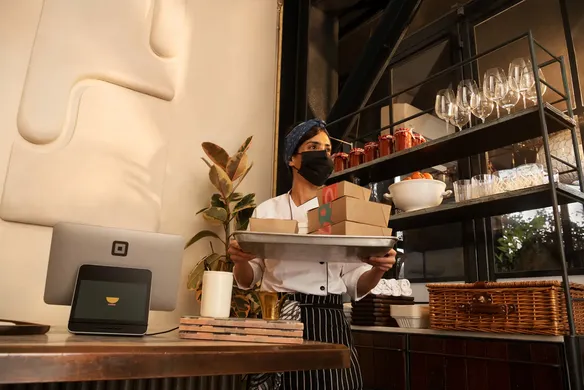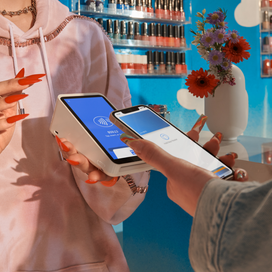Table of contents
An omnichannel strategy is a method that helps you create a seamless experience for customers across all the channels through which you sell. It encompasses the online and offline touch points of your brand, from a point-of-sale system to an Instagram shoppable post, and it’s not just for retailers anymore.
That means you can sell a collection of leather goods on social media, in a pop-up location, and online, and your loyalty program will follow your customer throughout their journey. Or you can run a restaurant that allows diners to order from QR codes, on your website, and in your brick-and-mortar location, and their experience will be connected each step of the way.
From sophisticated multitouch campaigns to lavish dining and in-store experiences, large businesses are doubling down on omnichannel. But small businesses can get in on the omnichannel game too.
Here is an overview of what an omnichannel strategy is, and how you can create an effective approach for your business.
What is an omnichannel strategy?
To stay relevant, businesses need to deliver a cohesive and consistent brand experience across all sales and marketing channels, whether they’re accessed digitally, in brick-and-mortar locations, or both. It’s about connecting the dots across your digital and physical presence. That’s where an effective omnichannel strategy comes into play.
For David Rusenko, the head of eCommerce at Square, the definition of a winning omnichannel strategy hasn’t changed, but consumer expectations have.
“As in everything, expectations rise,” he says. “Expectations for what was considered omnichannel three years ago was ‘buy online, pick up in store’— called BOPIS in retail. That’s just table stakes now.”
Restaurants are a prime example of how a true omnichannel approach is no longer confined to retail. “In restaurants the concept of omnichannel has really evolved,” Rusenko explains. “Now you’re talking about a single ordering platform that lets you do on-demand delivery, order pickup, offer shipping, all on the same platform.”
Imagine a wine supplier that ships bottles of wines and offers pickup and delivery options from the same platform that powers their in-store experience, describes Rusenko. “When you think about omnichannel, what better example than literally one platform that’s handling pickup, delivery, and dine-in?”
That connection, enabled by a central platform that knits together an integrated experience, is the definition of an omnichannel strategy that drives value for businesses.
What are the four pillars of a successful omnichannel strategy?
Before we get into ways to create your omnichannel strategy, it’s important to understand the elements that can help you give customers what they expect while also providing opportunities to charm and surprise them.
Here are four distinct pillars of a successful omnichannel approach:
- Sales: Your sales strategy directly influences your omnichannel strategy and can help you prioritize the channels that make the most sense for your audience.
- Marketing: You want your marketing messages to look consistent across your different channels. A unified omnichannel marketing strategy can help your customers feel connected to your brand on each channel you show up on.
- Fulfillment and logistics: Whether it’s a meal or a product, order fulfillment is the only way to get customers what they bought from you. It’s an important part of the omnichannel experience and can help you reinforce your brand promise on the last leg of the journey.
- Operations: To do omnichannel well, you need a system that ties all of your channels together. Square can help you turn your omnichannel ideas into reality with integrated tools that work together.
Omnichannel Strategy: Take Your Marketing to the Next Level
1. Understand your customers.
The first step toward crafting an effective omnichannel retail strategy or restaurant strategy is to understand who your customers are and how they buy from you. One way to do this is with a simple survey that asks people about their shopping and dining preferences. You can offer a discount to give your customers an incentive to complete the survey.
You might ask customers how they discover new products and menu items (social media, in-store shopping, word of mouth) or what sorts of items they’d be more likely to buy in person rather than online. That sort of information helps focus your efforts and clarify where different channels can reinforce one another. For instance, if tons of customers say they discover new items via Instagram, you know that’s a channel on which you should spend your energy.
Data is key here. There’s a slew of business metrics you can track to understand how customers interact with your business. Digitally that can include:
- The most popular pages on your website
- Reactions to changes in your product offerings
- Engagement from marketing emails
- Sales by device (mobile versus desktop)
- Social media conversion metrics
In your store or restaurant, track new versus returning customers as well as their buying patterns. What time of day are most purchases made? What is the frequency of purchases? All of this data provides a 360-degree view of the factors that influence your customers’ buying behaviors.
2. Offer in-store Wi-Fi in your physical location.
Increasingly consumers do their own product research while they’re in brick-and-mortar stores and restaurants. Research from Google found that 61% of people use their phones when in a restaurant or a bar. Additionally, 84% of consumers access the internet from their phones while in a store, and 65% use their phones to find coupons online, according to Forrester Research and RetailMeNot.
Offer in-store Wi-Fi to help usher these customers along their buying journeys. To make in-store and in-restaurant research even easier, integrate QR codes that link to product and nutritional information online.
3. Diversify where you sell.
Sell and market your products wherever your customers shop, browse, or simply look for more information. Most customers navigate between many touch points to purchase an item — brick-and-mortar locations; social media; online marketplaces such as Amazon and Etsy; your own website; review sites; and larger retailers that sell different brands, to name a few.
While you diversify, remember to keep your customer experience consistent. As consumers jump across multiple channels, they should encounter similar branding and pricing. Ninety percent of shoppers expect their experience to be consistent across all channels and devices.
4. Create educational content.
High-quality, engaging content is imperative when it comes to educating customers, to answering questions, and to instilling trust across channels. The more compelling content you can create to explain why purchasing from you is a good choice, the more you’ll sell.
Content marketing campaigns can take many forms: blog posts, social media, guides, customer reviews, and livestream video. Video content is engaging, helps with SEO, and performs well on social media. Consider creating explainer videos for your cornerstone products or services, or launch a video series of tutorials that showcase your area of expertise.
5. Integrate social media into your storefront.
Try to integrate social media into your brick-and-mortar experience.
Dressing rooms can have displays that let customers check out product reviews of what they’re trying on, a valuable complement to other try-before-you-buy methods. You can encourage customers to take photos of what they bought or ate and post it on Instagram for a prize. Or you can even have screens that showcase a live social media feed related to your products or industry.
QR codes are another technology that can take your omnichannel approach to the next level. There are many creative ways businesses can use QR codes to connect with customers, including using them to share details on the makers and chefs behind items and to recreate the ambiance of an in-store experience.
6. Offer free in-store pickup.
People — especially millennials — love to save on shipping costs. Try turning your brick-and-mortar store into a fulfillment center for your online channels so people can pick up their products without paying for shipping.
Our Future of Retail report found that nearly three in 10 shoppers would rather pick up items curbside or in a physical store instead of getting them delivered because they can get those purchases quicker. And over a quarter of consumers who would rather pick up their items directly say that they also shop in stores after the pickup, continuing the omnichannel sales cycle.
7. Leverage your expertise
Small businesses have a leg up with omnichannel. Since you’re homegrown, you likely have loads of expertise about your products and industry. Leverage that in your business by offering tutorials and workshops. Online, integrate live chat or even the ability to video chat with an expert into your website.
There are also opportunities to bring your expertise to life by training your staff to provide a seamless omnichannel experience. With social media training for instance, they can share their knowledge with customers across social channels and speed up sales at the same time.
An omnichannel selling strategy can help you reach more customers and deepen their loyalty by making the experience with your brand feel consistent and accessible. And it’s an approach that’s a natural fit for small businesses, since the levers and tools that can help you tie your channels together are already within reach.
![]()











